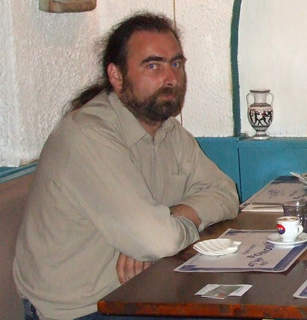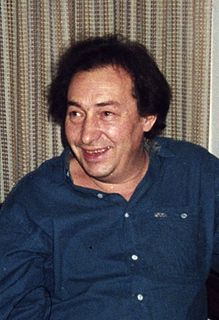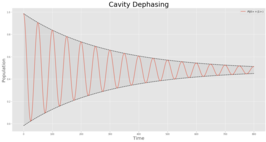Metallic hydrogen is a phase of hydrogen in which it behaves like an electrical conductor. This phase was predicted in 1935 on theoretical grounds by Eugene Wigner and Hillard Bell Huntington.

In superconductivity, Homes's law is an empirical relation that states that a superconductor's critical temperature (Tc) is proportional to the strength of the superconducting state for temperatures well below Tc close to zero temperature multiplied by the electrical resistivity measured just above the critical temperature. In cuprate high-temperature superconductors the relation follows the form
The fractional quantum Hall effect (FQHE) is a physical phenomenon in which the Hall conductance of 2D electrons shows precisely quantised plateaus at fractional values of . It is a property of a collective state in which electrons bind magnetic flux lines to make new quasiparticles, and excitations have a fractional elementary charge and possibly also fractional statistics. The 1998 Nobel Prize in Physics was awarded to Robert Laughlin, Horst Störmer, and Daniel Tsui "for their discovery of a new form of quantum fluid with fractionally charged excitations" Laughlin's explanation only applies to fillings where is an odd integer. The microscopic origin of the FQHE is a major research topic in condensed matter physics.

A quantum point contact (QPC) is a narrow constriction between two wide electrically conducting regions, of a width comparable to the electronic wavelength.

Andreev reflection (AR), named after the Russian physicist Alexander F. Andreev, is a type of particle scattering which occurs at interfaces between a superconductor (S) and a normal state material (N). It is a charge-transfer process by which normal current in N is converted to supercurrent in S. Each Andreev reflection transfers a charge 2e across the interface, avoiding the forbidden single-particle transmission within the superconducting energy gap.
The spin qubit quantum computer is a quantum computer based on controlling the spin of charge carriers in semiconductor devices. The first spin qubit quantum computer was first proposed by Daniel Loss and David P. DiVincenzo in 1997, also known as the Loss–DiVicenzo quantum computer. The proposal was to use the intrinsic spin-½ degree of freedom of individual electrons confined in quantum dots as qubits. This should not be confused with other proposals that use the nuclear spin as qubit, like the Kane quantum computer or the nuclear magnetic resonance quantum computer.

Mesoscopic physics is a subdiscipline of condensed matter physics that deals with materials of an intermediate size. These materials range in size between the nanoscale for a quantity of atoms and of materials measuring micrometres. The lower limit can also be defined as being the size of individual atoms. At the micrometre level are bulk materials. Both mesoscopic and macroscopic objects contain many atoms. Whereas average properties derived from constituent materials describe macroscopic objects, as they usually obey the laws of classical mechanics, a mesoscopic object, by contrast, is affected by thermal fluctuations around the average, and its electronic behavior may require modeling at the level of quantum mechanics.

A pump is an alternating current-driven device that generates a direct current (DC). In the simplest configuration a pump has two leads connected to two reservoirs. In such open geometry, the pump takes particles from one reservoir and emits them into the other. Accordingly, a current is produced even if the reservoirs have the same temperature and chemical potential.
Subir Sachdev is Herchel Smith Professor of Physics at Harvard University specializing in condensed matter. He was elected to the U.S. National Academy of Sciences in 2014, and received the Lars Onsager Prize from the American Physical Society and the Dirac Medal from the ICTP in 2018. He was a co-editor of the Annual Review of Condensed Matter Physics from 2017-2019.
In physics, persistent current refers to a perpetual electric current, not requiring an external power source. Such a current is impossible in normal electrical devices, since all commonly-used conductors have a non-zero resistance, and this resistance would rapidly dissipate any such current as heat. However, in superconductors and some mesoscopic devices, persistent currents are possible and observed due to quantum effects. In resistive materials, persistent currents can appear in microscopic samples due to size effects. Persistent currents are widely used in the form of superconducting magnets.

In condensed matter physics, Luttinger's theorem is a result derived by J. M. Luttinger and J. C. Ward in 1960 that has broad implications in the field of electron transport. It arises frequently in theoretical models of correlated electrons, such as the high-temperature superconductors, and in photoemission, where a metal's Fermi surface can be directly observed.
The SP formula for the dephasing rate of a particle that moves in a fluctuating environment unifies various results that have been obtained, notably in condensed matter physics, with regard to the motion of electrons in a metal. The general case requires to take into account not only the temporal correlations but also the spatial correlations of the environmental fluctuations. These can be characterized by the spectral form factor , while the motion of the particle is characterized by its power spectrum . Consequently, at finite temperature the expression for the dephasing rate takes the following form that involves S and P functions:

Piers Coleman is a British-born theoretical physicist, working in the field of theoretical condensed matter physics. Coleman is Professor of Physics at Rutgers University in New Jersey and at Royal Holloway, University of London.

A unified model for Diffusion Localization and Dissipation (DLD), optionally termed Diffusion with Local Dissipation, has been introduced for the study of Quantal Brownian Motion (QBM) in dynamical disorder. It can be regarded as a generalization of the familiar Caldeira-Leggett model.

Yaroslav Mikhaylovich Blanter is a Russian physicist, an expert in the field of extractive metallurgy and condensed matter physics. As of 2011, he is the Antoni van Leeuwenhoek professor at the Delft University of Technology.

Arkady Girshevich Aronov was a Russian and Israeli theoretical condensed matter physicist, notable for his achievements in physics of semiconductors and in mesoscopic physics.
Bose–Einstein condensation can occur in quasiparticles, particles that are effective descriptions of collective excitations in materials. Some have integer spins and can be expected to obey Bose–Einstein statistics like traditional particles. Conditions for condensation of various quasiparticles have been predicted and observed. The topic continues to be an active field of study.
Periodic instantons are finite energy solutions of Euclidean-time field equations which communicate between two turning points in the barrier of a potential and are therefore also known as bounces. Vacuum instantons, normally simply called instantons, are the corresponding zero energy configurations in the limit of infinite Euclidean time. For completeness we add that ``sphalerons´´ are the field configurations at the very top of a potential barrier. Vacuum instantons carry a winding number, the other configurations do not. Periodic instantons werde discovered with the explicit solution of Euclidean-time field equations for double-well potentials and the cosine potential with non-vanishing energy and are explicitly expressible in terms of Jacobian elliptic functions. Periodic instantons describe the oscillations between two endpoints of a potential barrier between two potential wells. The frequency of these oscillations or the tunneling between the two wells is related to the bifurcation or level splitting of the energies of states or wave functions related to the wells on either side of the barrier, i.e. . One can also interpret this energy change as the energy contribution to the well energy on either side originating from the integral describing the overlap of the wave functions on either side in the domain of the barrier.

Mordehai "Moty" Heiblum is an Israeli electrical engineer and condensed matter physicist, known for his research in mesoscopic physics.
Pritiraj Mohanty is a physicist and entrepreneur. He is a professor of physics at Boston University. He is most known for his work on quantum coherence, mesoscopic physics, nanomechanical systems, and nanotechnology with a recent focus on biosensing and nanomechanical computing.











